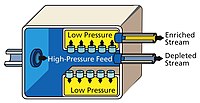
Photo from wikipedia
Abstract Chloride diffusion coefficients, which include the chloride diffusion coefficient D RCM measured from the rapid chloride migration (RCM) test, the instantaneous chloride diffusion coefficient D ins and the apparent… Click to show full abstract
Abstract Chloride diffusion coefficients, which include the chloride diffusion coefficient D RCM measured from the rapid chloride migration (RCM) test, the instantaneous chloride diffusion coefficient D ins and the apparent chloride diffusion coefficient D a determined by the chloride natural diffusion test, are the important indexes for the chloride permeability of concrete. D a denotes the average diffusion coefficient over the whole exposure period. Both D RCM and D ins essentially represent the instantaneous diffusion coefficient, which reflect the influence of real-time changing environmental factors on the chloride permeability of concrete. In this paper, the method for determining the time-dependent model of D ins was firstly studied based on Fick’s second law. Subsequently, the time-dependent models of D ins and D RCM were respectively established through the chloride natural diffusion test under artificial simulation marine environment and the RCM test. According to the comparative analysis of D ins and D RCM , the RCM modified factor f ( t ) was proposed to quantify the relationship between D RCM ( t ) and D ins ( t ), and the modified model of D RCM was established. Finally, the suggested modified model of D RCM was applied to predict the chloride concentrations in concrete, which was verified by experimental results. Results showed that the values of D ins and D RCM were identical at the initial exposure time, while D RCM gradually came to be larger than D ins with the increasing of exposure time. The main reason for the difference between D ins and D RCM is that the process of chloride diffusion in concrete is influenced by convection and chloride binding during the chloride natural diffusion test, which can be ignored in the RCM test.
Journal Title: Construction and Building Materials
Year Published: 2019
Link to full text (if available)
Share on Social Media: Sign Up to like & get
recommendations!